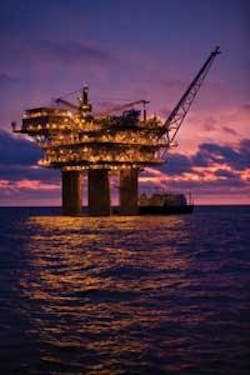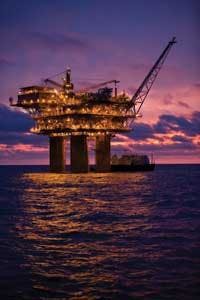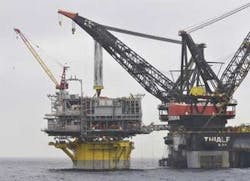Deepwater fueling US production increase
David Paganie - Managing Editor
The US is set to post its first increase in domestic oil production since 1991, fuelled mostly by a handful of deepwater fields in the US Gulf of Mexico. These include recent startups at BP-operated Thunder Horse and BHP-operated Shenzi, and Chevron-operated Tahiti which is slated for first production in the second quarter of this year. Gas production from new deepwater fields also will contribute to the upward trend of supply from offshore, accounting for 15% of total domestic gas production in 2007 and 21% in 2030, according to the Energy Information Administration.
Meanwhile, recent project sanctions and a string of discoveries further validate the continued strength in the deepwater sector.
New deepwater production
Thunder Horse is ramping up to capacity with six wells flowing through the production, quarters, and drilling platform at a combined rate of 260,000 b/d of oil, making it the second largest producing field in North America, after Prudhoe Bay, says Andy Inglis, BP’s chief executive of Exploration & Production. Inglis says they have more than enough wells to fill Thunder Horse to capacity which is 280,000 b/d of oil. Full field development is expected to include 22 production wells and 11 water injectors.
“Delivery of Thunder Horse has been technically challenging, but the technology developed and applied here will benefit the next wave of our developments in the deepwater GoM,” Inglis says.
Meanwhile, BP plans to bring online a second phase of its Atlantis field by the end of this year. Production started in October 2007 through wells from the south area. New production will come from one to three subsea wells in the north area to fill the field’s semisubmersible production platform to capacity which is 200,000 b/d of oil and 180 MMcf/d of natural gas. Full field development is expected to include up to 18 subsea wells.
Through 2015, BP plans to expand in the Miocene fairway which has delivered Thunder Horse and Atlantis, and to develop Dorado, King South, Puma, Tubular Bells, Kodiak, and Freedom. The company also plans to continue exploration in the Paleogene, where Kaskida was discovery.
BHP Billiton has started production from the Shenzi field where a TLP with capacity to process 100,000 b/d of oil and 50 MMcf/d of natural gas is moored. The Shenzi field comprises Green Canyon blocks 609, 610, 653, and 654. Initial field development includes seven subsea wells tied back to a TLP, with full field development expected to expand to a total of 15 production wells and future water injection wells. Crude oil is transported via a 20-in. (51-cm) diameter pipeline connecting to platform B in Ship Shoal block 332, while natural gas is exported via the Cleopatra pipeline.
Hook-up and commissioning of the Chevron-operatedTahiti spar continues, with first production expected in the second quarter of this year. All six production wells have been completed. The platform has capacity for 125,000 b/d of oil and 70 MMcf/d of natural gas.
Other deepwater floating production systems expected to add to oil capacity this year include: Murphy-operated semisubmersibleThunder Hawk (45,000 b/d of oil, expandable to 60,000 b/d), Helix-operated Helix Producer I floating production unit (30,000 b/d of oil), and ATP-operated ATP Titan MinDOC (25,000 b/d of oil; 60 MMcf/d of gas).
Thunder Hawk left Ingleside, Texas, in the first quarter of this year, Helix Producer was scheduled to depart its conversion yard in April, and ATP Titan is scheduled to sail out in the middle of this year. ATP has revised its development plans for the Telemark Hub area, which originally called for the installation of two MinDOC platforms. The first MinDOC, ATP Titan, will be moored in the northern part of the Telemark Hub area which includes Mirage and Morgus fields. After those reserves are drained, plans are to move the MinDOC to Atwater Valley block 63, where the second MinDOC was to be installed, to recover the remaining reserves through a subsea well. ATP says it will use the second MinDOC at another ATP location in the future.
Meanwhile, the Cascade-Chinook project is moving ahead on schedule, according to Cesar Palagi, Walker Ridge asset manager for Petrobras America. The FPSO for Phase 1 of the development is under construction in Singapore and is expected to arrive in the Gulf in early 2010, for first production in June, Palagi says. Heerema’sBalder was scheduled to start laying the pipe-in-pipe on the field in April.
Nexen says it expects first production in 2010 from its Sargent discovery. The development includes a single-well tieback from the discovery well in Garden Banks block 339 to existing infrastructure in the area.
Recent project sanctions
Anadarko has sanctioned the $1.3-billion Caesar Tonga development. The initial phase calls for four subsea wells (40,000 b/d of oil) tied back to the Anadarko-operatedConstitution spar, with first production expected in 1Q 2011. The development area is estimated to hold resources in the range of 200-400 MMboe.
Eni has sanctioned the Longhorn Phase II and Appaloosa projects, both in the Greater Longhorn area in Mississippi Canyon. Longhorn Phase II provides for an additional subsea well tied in to the Corral platform. First production is expected this coming July and will peak at 30-50 MMcf/d of natural gas. Processing capacity on the Corral platform will be upgraded to accommodate first oil from Appaloosa, expected in January 2010 with a peak rate to reach 7,500 b/d of oil. Eni is planning an appraisal campaign at the Greater Longhorn area, estimated to hold resources of 100 MMboe, in the second half of this year.
Meanwhile, Chevron has initiated front-end engineering and design of a new hub to develop the Jack and nearby St. Malo discoveries, says George Kirkland, Chevron’s executive VP of Upstream and Gas.
The platform will be equipped with capacity to process 120,000-150,000 boe/d, he says. It will be moored in 7,000 ft (2,134 m) of water. Jack and St. Malo are estimated to hold combined recoverable resources exceeding 500 MMbbl.
Early design work also is under way for the development of the Shell-operated Vicksburg discovery in DeSoto Canyon block 353.
Discoveries
Noble Energy has hit pay on the Santa Cruz prospect in Mississippi Canyon blocks 519/563. The discovery well, in 6,515 ft (1,986 m) of water, was drilled to approximate TD of 18,900 ft (5,761 m). Open-hole logging indicated over 140 ft (43 m) of net gas condensate pay and more than 110 ft (34 m) of net oil pay in multiple high-quality reservoirs.
Noble’s development plans include a subsea tieback to nearby infrastructure, with first production expected in 2011.
Chevron has made a discovery on the Buckskin prospect in Keathley Canyon block 872 about 44 mi (71 km) west of the company’s Jack discovery. Buckskin No. 1 well, drilled in 6,920 ft (2,109 m) of water to 29,404 ft (8,962 m) deep, encountered more than 300 ft (91 m) of net pay. Additional work on the field is required to determine the extent and commercial viability of the discovery, Chevron says.
Anadarko has hit pay on the Shenandoah prospect in Walker Ridge block 52. The discovery well, drilled in 5,750 ft (1,753 m) of water to 30,000 ft (9,144 m) deep, encountered more than 300 ft (91 m) of net oil pay.
Anadarko and partners are evaluating the well results and the next steps toward future appraisal activity.
“Initial data indicate the Shenandoah discovery has reservoir properties that appear to be of much higher quality than industry has seen previously in the emerging Lower Tertiary play,” says Bob Daniels, Anadarko senior VP of worldwide exploration.
Anadarko also made an oil discovery at the Heidelberg prospect in Green Canyon block 859. The discovery well, drilled in 5,000 ft (1,524 m) of water to 28,500 ft (8,687 m) deep, encountered more than 200 ft (61 m) of net oil pay in several Miocene sands.
“The Heidelberg discovery further validates our geologic understanding of the subsalt Miocene trend,” Daniels says. “The well encountered the same age sands and reservoir characteristics similar to the previously announced Caesar/Tonga discoveries.”
Heidelberg’s proximity to Anadarko’s 100%-ownedConstitution spar enhances the company’s flexibility to consider a variety of development options after further appraisal, which Anadarko says it intends to conduct in the second half of this year.
Mariner Energy has made a gas discovery at the Bushwood prospect in Garden Banks block 463. The Bushwood No. 1 (formerly Geauxpher No. 3) discovery well, drilled in 2,700 ft (823 m) of water to 25,300 ft (7,711 m) deep, logged more than 260 ft (79 m) TVT of net gas pay in multiple sands, with more than 150 ft (46 m) TVT of net gas pay found in the deeper exploratory section. Mariner expects first production from its adjacent Geauxpher discovery in Garden Banks block 462 in the first half of this year. The field is tied back 40 mi (64 km) to platform A in Garden Banks block 72.
LLOG Exploration Co. has claimed nine additional discoveries from its 2008 Gulf of Mexico drilling program, three are in deepwater: Mississippi Canyon block 754, Green Canyon block 141, and Green Canyon block 201.
Meanwhile, the company has five deepwater discoveries in development including Mississippi Canyon block 72 which is scheduled for first production in the third quarter of this year. Its discoveries in Green Canyon block 448, Green Canyon block 141, and MC 754 are targeted for first production by mid-2010, and Mississippi Canyon block 503 is projected to come on line in early 2011.
Plains Exploration & Production Co. says data from its Friesian No. 2 discovery well show a strong correlation, both geologic and in pressure, to the initial Miocene pay sands at Tahiti. The well was drilled in Green Canyon block 643 approximately 3,300 ft (1,006 m) due south of the initial discovery well.
The PXP-operated Friesian No.2 well was drilled to 28,989 ft (8,836 m) TD and encountered approximately 389 ft (119 m) of net oil in Miocene-age sands.
These pay sands are the uppermost field pays at the Tahiti field approximately eight mi (13 km) to the west across the basin syncline, the company says.
PXP and its partner have opted to deepen the Friesian No.2 well by an additional 3,500 ft (1,067 m) to 32,500 ft (9,906 m) true vertical depth to test the main field equivalent sands such as the M15, M18, M21A, and M21B at Tahiti. Several of these Tahiti pay sands have flow tested in excess of 25,000 b/d of oil, according to PXP.
Diamond Offshore’s semisubmersible drilling rigOcean Monarch was scheduled to arrive on site in early March to begin deepening the well. First production is targeted in 2012.
Canada
This year, well completion and installation work is scheduled to kick off on the EnCana-operated Deep Panuke project offshore Nova Scotia, Canada. The development calls for the installation of five gravity-based wellhead protection structures, one for each production well and one for the acid gas injection well, in 45 m (148 ft) of water. First gas is expected to be delivered in late 2010 through a 175-km (109-mi) subsea pipeline. Rowan’s jackupRowan Gorilla III is contracted to complete the subsea production wells and drill the new injector. The 180-day drilling program is scheduled to begin by late 2009/early 2010.
Offshore Newfoundland, StatoilHydro Canada has made a discovery on the Mizzen prospect (EL 1049) in 1,100 m (3,609 ft) of water. Transocean’s semisubmersibleHenry Goodrich drilled the discovery well. StatoilHydro plans to file an application for a Significant Discovery License (SDL) in the coming months. StatoilHydro operates Mizzen with a 65% working interest. Husky Energy Inc. holds the remaining 35%.




